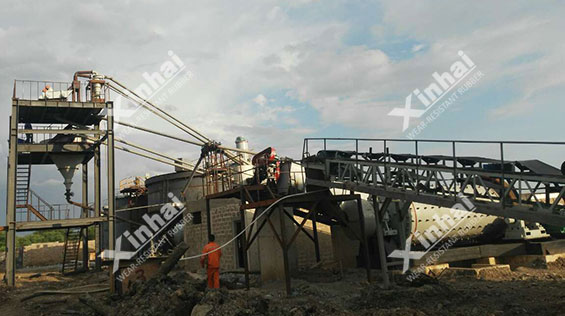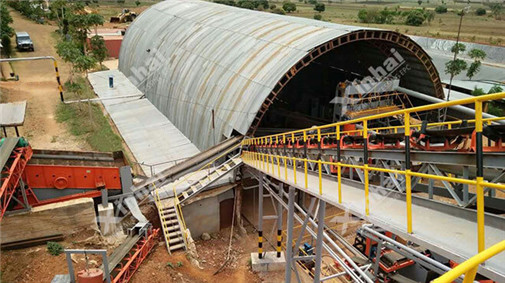Tanzania is the fourth largest gold producing country in Africa, and in recent years, many Chinese enterprises have gone to Tanzania for mining development and investment. However, there are few in-depth studies on some difficult to select gold mines. This article takes a micro disseminated gold mine in Tanzania as an example to introduce the research process of mineral processing technology.

(1) Mineral composition
The main valuable element in the ore of this gold deposit is gold, with a grade of 5 17 g/t, with harmful elements arsenic and sulfur grades of 0 43% and 2 50%. The main metallic mineral in gold ore is pyrite (7 80%), toxic sand (5 95%), magnetite (2 80%), siderite (2 50%, with small amounts of hematite, ilmenite, sphalerite, chalcopyrite, etc; Quartz (29 50%, feldspar (21 50%, carbonate (7 50%), chlorite (7 00%), biotite (6 00%, clay minerals (5 00%, with a small amount of apatite, carbonaceous minerals, etc.
(2) Embedding features
Among the gold deposits, encapsulated gold accounts for 49%, intergranular gold accounts for 47%, and fracture gold accounts for 4%. The gold mineral particles in the ore are relatively small, mainly composed of fine-grained gold, followed by fine-grained gold. The content of medium and coarse-grained gold is relatively low, with fine-grained gold (0.01-0.037 mm) accounting for 78.5% and fine-grained gold (<0.01 mm) accounting for 14%. The natural form of gold is mainly angular and branched, followed by wheat grain and leaf shapes.

Based on the properties of the ore and the occurrence state of gold, this experimental study conducted exploratory experiments such as gravity separation, full mud cyanide leaching, and flotation, and optimized the process based on the obtained results.
(1) Reselection
In the original ore, intergranular gold and fracture gold account for 47% and 4%, respectively. Therefore, a shaking table was chosen to conduct gravity separation and recovery experiments during the research process. The experimental results show that under the condition of grinding fineness of -0.075mm accounting for 75%, the gold grade of the re selected concentrate is 49.50g/t, and the yield is 2.20%; The gold grade in the tailings is high, which indicates that the embedded particle size of the gold ore is relatively fine, and there is no significant difference in mineral density. Therefore, the gravity separation process is not suitable.
(2) Full mud cyanide leaching
In the full mud cyanide leaching test, when the grinding fineness of -0.075mm accounts for 85% and the leaching time is 24 hours, the gold leaching rate is 44.29%; Improve the grinding fineness to -0 When 075mm accounts for 95%, the cyanide gold leaching rate is 46.62%; Even if the grinding fineness is further increased to -0.040mm, which accounts for 96%, the gold leaching rate is only 47%, and there is no significant improvement, indicating that the original gold embedded particle size is relatively fine and difficult to dissociate. Therefore, the entire mud cyanide leaching process is not suitable for this ore.
(3) Flotation
The single flotation process consists of one roughing, three sweeping, and two refining, with a grinding fineness of -0 075mm accounts for 70%, and the dosage of crude collectors butyl yellow medicine and butylammonium black medicine is 60g/t and 40g/t, respectively. The dosage of foaming agent No. 2 oil is 40g/t. The experimental indicators obtained are: the crude concentrate gold grade is 53.88g/t, the gold recovery rate is 62.53%, and the tailings gold grade is 0.81g/t.
The indicators examined in flotation experiments mainly include grinding fineness, amount of activator, type and amount of collector, and amount of foaming agent.
According to the grinding fineness test, it is determined that the grinding fineness -0.075mm accounts for 70% of the appropriate proportion; According to the activator dosage test, the activator copper sulfate dosage is determined to be 200 g/t; After conducting experiments on the types and dosages of collectors, it was determined that the type of collector was a combination of isoamyl yellow medicine and butylammonium black medicine. The dosages were: 60g/t of crude isoamyl yellow medicine and 40g/t of butylammonium black medicine; Scan and select 40 g/t of isoamyl yellow medicine and 20 g/t of butylammonium black medicine; Scan and select 20g/t of diisopentyl yellow medicine and 10g/t of butylammonium black medicine; Scan and select 10g/t of triisoamyl yellow medicine and 5g/t of butylammonium black medicine.
Based on the results of the conditional experiment and the properties of the ore, the flotation process of "one roughing, three sweeping, and two refining" is selected. The gold grade of the gold concentrate obtained from the closed circuit test is 44 70 g/t, gold recovery rate 83.56%; The gold grade of tailings is 0.93g/t, with a gold recovery rate of 16.44%. This part of tailings is mainly composed of fine-grained gold containing pyrite and arsenopyrite, which does not meet the recovery requirements. Therefore, gold is recovered from this tailings through leaching methods.
Research has found that most gold minerals are encapsulated in pyrite and arsenopyrite minerals. Through experiments to improve grinding fineness and adjust leaching time, the leaching conditions were determined to be: re grinding fineness -0.075mm accounting for 95%, sodium cyanide dosage of 1400g/t, lime dosage of 4000g/t, and leaching time of 24 hours.
After improving the grinding fineness of flotation tailings and then leaching, the gold recovery rate in the operation is 34 41%, with a gold recovery rate of 5 66%, the total gold recovery rate of the flotation+tailings leaching process is 89 22%, the effect is good.
conclusion
The final decision was made to use a flotation+tailings leaching process for Tanzania's fine disseminated gold mine. Under closed circuit test conditions, the gold concentrate obtained had a gold grade of 44.70g/t and a total gold recovery rate of 89.22%, achieving significant recovery results.